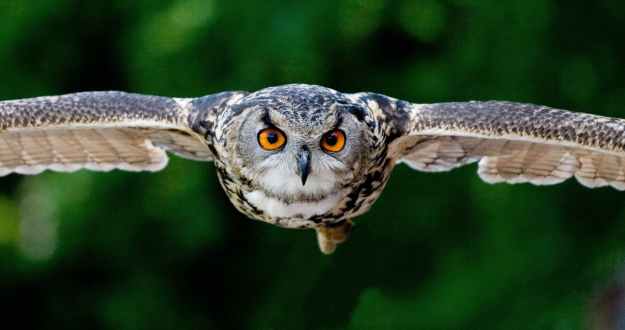
Photo by HMaria from Pixabay • A great horned owl is capable of almost silent flight, which helps this predatory bird take prey by surprise. Many myths and superstitions surround the world’s owls, but the truth about owls is often more fascinating.
Great horned owls become feathered phantoms after sunset
In late September, I began hearing a great horned owl near my home. The sonorous hoots resonated from a distant ridge the other side of the road. The ridge was logged this year and many of the large white pines are gone. I wasn’t at all optimistic the owl would return.
There’s nothing to send shivers traveling along your spine like listening to these haunting hoots from a creature that’s well hidden from human eyes by the cloak of darkness.
Or a cloak of fog and mist, as the case may be. This returning owl calls most often near dawn and dusk. On foggy mornings, of which there has been plenty, the owl’s still been calling as I leave for work.
It’s no wonder that owls have also become popular motifs for the celebration of the Halloween holiday. Just remember there’s more to these creatures of the night than perhaps meets the eye. Owls may be our neighbors, but we’ll never truly belong to their world, which must be why they continue to intrigue us.
While human culture has turned owls into beloved creatures, keep in mind these birds are fierce and ferocious predators. For young American crows in their nests, this owl is the stuff of their avian nightmares. It’s no wonder that crows, some of their numbers no doubt having witnessed their peers taken by the great horned owl as prey when young and helpless, grow up with an abiding hatred of this large nocturnal raptor.
Flocks of adult crows form quickly when an owl is discovered at a roost during the daylight hours. With safety in numbers, the crows mercilessly hound and harry the unlucky owls.
Quite often, a crow’s sharp vision is required to detect a motionless owl at its daytime roost. Great horned owls have a plumage of mottled grays and browns, as well as some white feathers on the chin and throat. This plumage helps them blend into their surroundings. Even when on the move, the great horned owl rarely attracts attention. They can fly in almost perfect silence on wide wings that can stretch out to a wingspan of 4.6 feet.
I know about their silent flight from firsthand experience. Back in the early 2000s I visited Orchard Bog in Shady Valley in Johnson County in early spring for a chance to witness the evening display of American woodcocks. While waiting with other birders for the evening show, I noticed a large shadow moving low over the fields heading toward us. As the bird got closer, it became recognizable as a great horned owl. The owl barely diverted from its flight. In fact, it flew just over our heads, gliding silently on wide wings. I still marvel at how the owl’s wings made no noise whatsoever. The owl continued to glide over the fields until we lost it in the dusk.
On another occasion I also witnessed how, when they want to do so, great horned owls can be absolutely silent. While vacationing on Fripp Island, South Carolina, in the 1990s, I would accompany my family for dusk golf cart excursions. We liked to pull off the side of the road on a causeway that crossed a series of tidal creeks and marsh. On that occasion, a great horned owl flew from nearby woodlands to land on a gnarled snag that rose above the marshland vegetation. Although the owl arrived on silent wings, it soon interrupted the silence with resonant hoots that carried over the marshes. The owl returned to the same snag for two additional evenings during our vacation stay.
I’ve seen other great horned owls over the years in locations from South Carolina and Florida to Utah and and Virginia. I’ve heard many more of these large owls than I have ever been able to get into focus in my binoculars. It’s still a thrill to get even a brief sighting of these impressive birds.
I’ve always thought about trying to locate the owls in residence at my home. I’ve scanned the silhouettes of the tree line in the direction of their hoots, but I’ve not ventured forth on a more methodical search. Perhaps I’ll save that as a Halloween activity this year. I’ll more likely continue to enjoy the owl’s haunting serenade and let a cloak of mystery continue to shroud this fascinating bird.



















